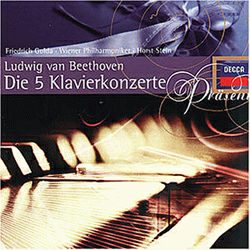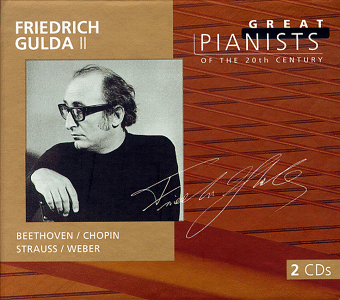Friedrich Gulda(16th May 1930~27th Jan. 2000)
[ Wolf-Genius in Sheep's Clothing ]
 [ Left ] Friedrich Gulda(photo
from Philips
Homepage)
[ Left ] Friedrich Gulda(photo
from Philips
Homepage)
Someone says Friedrich Gulda is very excellent, but someone he is out of mind as a classical pianist. But I think he has all conditions that we called him excellent, individuality and technique in his record at least.
Friedrich Gulda
was born at Vienna in a teacher's family, his father was
a dilletante musician. He learned piano by Felix Pazofsky
from 7 years old, and entered Vienna music academy in
1942. He was taught piano by Bruno Seidlhofer, and
musical theory by Joseph Marx(composer, also taught Rudolf
Serkin). He won the
first prize of Geneva International competition on 1946.
Jörg Demus and Paul Badura-Skoda are similar to him by
age, and they began to be called "Viennese
troica". He began concert tour from 1947, and
contracted Decca in 1949, the year of advent of magnetic
tape instead of 78s. The earliest commercial recording I
know is Beethoven's Sonata No.14 and 31 in 1949(Decca).
He succeeded in Carnegie Hall début on
1950, beginning to get international fame. He was famous
for the player of Beethoven and called the hope
succeeding Backhaus
and Kempff's tradition. His Beethoven based on fast tempi
and activity by excellent technique is worth be listened
once from now on. Except for Beethoven, his favorites
were J.S.Bach, Mozart, and Schubert. In special, Mozart
has got the high reputation by the big scale. Friedrich
liked to play Chopin, Debussy, and Ravel, so did not
confined himself in the German-Austrian repertoire.
He was totally against any authorities.
He returned Beethoven ring offered by Vienna Academy
against its authoritism, and was famous for appearing at
concert in a casual suit. So he was nicknamed
'Terrorist-Pianist', which was a barrier or prejudice to
the traditional classical music fans. He began to include
jazz works by himself in his concert programs, which of
course resulted in much controversies. One or two year
before death, he played trick on his friends by fake
death report of his own and perplexed them by appearing
in front of them, really dying of heart failure before 5
months of the 70th birthday on 27th Jan. 2000.
 Already
he passed away, and considerably reduced the recording of
classical repertoires from 1980s. In 1990s, his live
recordings are mostly composed of Jazz, transcriptions,
and his own compositions(jazz-likes). Therefore, if we
want to listen his classical repertoires, unhappily we
should select his 'somewhat older' 1950~70s recordings.
Moreover, his favorite is Beethoven, most of which are
not released internationally or not easy to buy, because
in the stereo era he contracted with independent labels
such as Amadeo(Austria) and MPS(West Germany). The CD
releases of these recordings are by major distributors'
license(HMF, Polygram...) from time to time but not
often, and recordings by Decca is available only partly
and recently. In short, Gulda is not lucky in CD reissue.
Already
he passed away, and considerably reduced the recording of
classical repertoires from 1980s. In 1990s, his live
recordings are mostly composed of Jazz, transcriptions,
and his own compositions(jazz-likes). Therefore, if we
want to listen his classical repertoires, unhappily we
should select his 'somewhat older' 1950~70s recordings.
Moreover, his favorite is Beethoven, most of which are
not released internationally or not easy to buy, because
in the stereo era he contracted with independent labels
such as Amadeo(Austria) and MPS(West Germany). The CD
releases of these recordings are by major distributors'
license(HMF, Polygram...) from time to time but not
often, and recordings by Decca is available only partly
and recently. In short, Gulda is not lucky in CD reissue.
But Beethoven
fans would not want to pass his recordings. The most
important one is surely the second complete sonatas in 1967(Amadeo). First of all, his technique is marvelous.
It is said that a pianist said 'beast-like technique'
about the Hammerklavier in this set. Most of all, his
playing is fresh and with much musical activity and
spontaneity. This set reveals Gulda's thought more
clearly than his older one recorded from 1950 to 1958 by
Decca. But this set is not only rare but also deficient
of 'sincerity' - only sum of 9 single CDs, and devoid of
any liner notes. The next is complete concertos with Vienna Philharmonic
conducted by Horst Stein(Decca, 1970 & 1971). Stein's support and the orchestra is
undoubtedly the first level in traditional view, and
Gulda's playing is also impressive - bright but with a
grand scale. But Decca has not yet released this
recording as CD internationally - only to get the German
or Japanese local versions. The complete cello
musics(sonatas and variations) with Pierre Fournier is
very good(DG Dokumente). Gulda's spontaneity is perfectly
fused with Fournier's fluent and graceful music(See his
tribute to Pierre Fournier in his
page). Gulda's ability
in chamber music is enough to enjoy this set. His
Diabelli variations(MPS; HMF released CD) is to be
categorized as the Amadeo sonata set in style. The fast
tempo and precise technique is evident.
I recommend his individual playing of
Mozart next to Beethoven. He recorded Mozart many times,
but much of them is not available now. Sonata Nos.11, 13,
and 15 are recorded by Amadeo, but almost not available.
K.570 and 576 and Fantasy is released by DG. In concerto
recordings, Nos.
20, 21(1974), 25, and 27(1975) with Vienna Philharmonic
and Abbado is the first choice(DG). Abbado's conducting is somewhat debatable,
but piano is one of the individual performance of this
repertoire without doubt. Moreover, this attractive
recording is released as budget(double) format. Other
than this easily available CD is only Teldec issues -
Nos. 23 and 26, double concerto(with Chic Corea) with
Harnoncourt and Royal  Concertgebouw.
He had a high reputation in Schubert's works, but it's
difficult to get his recordings - Sonata No.16 in a
minor(Amadeo), Impromptus D.899 and Musical
moments(Columbia). Bach recording is rarer -
Well-Tempered Clavier Book I & II(MPS, licensed by
Philips Duo) is one of the 'Cult recordings'. Recital in
Amadeo label includes 'Italian Concerto BWV.971. Recently
Philips released his early Decca recordings by Pianist
series. Vol.1 is for Debussy/Ravel, and Vol.2 contains
Weber's Konzertstück, R.Strauss' Burleske, Chopin's
concerto No.1 and Ballades, etc. Weber and Strauss is
interesting and Balakirev's edition of Chopin's Concerto
No.1 is rarely heard. Ballade can convey Gulda's face as
the best technician in his contemporaries.
Concertgebouw.
He had a high reputation in Schubert's works, but it's
difficult to get his recordings - Sonata No.16 in a
minor(Amadeo), Impromptus D.899 and Musical
moments(Columbia). Bach recording is rarer -
Well-Tempered Clavier Book I & II(MPS, licensed by
Philips Duo) is one of the 'Cult recordings'. Recital in
Amadeo label includes 'Italian Concerto BWV.971. Recently
Philips released his early Decca recordings by Pianist
series. Vol.1 is for Debussy/Ravel, and Vol.2 contains
Weber's Konzertstück, R.Strauss' Burleske, Chopin's
concerto No.1 and Ballades, etc. Weber and Strauss is
interesting and Balakirev's edition of Chopin's Concerto
No.1 is rarely heard. Ballade can convey Gulda's face as
the best technician in his contemporaries.
Peter Cossé referred on his gifts 'Wolf-genius in sheep's clothing(ein genialer Wolf im Schafspelz)' in the liner note of Philips pianist series(Vol.2, 456 820-2), comparing the recording of Beethoven's Concerto No.1 with Böhm(1951) to that with Stein(1970). It's interesting expression from which we infer the face of Gulda in a tail coat at concert, and witty compression of his musical essence - an excellent player who tended to play jazz later, unhappy to the classical music fans.
[ Right ] Gulda, Series II ; from Amazon(Germany division)
(c) 2000~ , Youngrok LEE ; Link free, but please get my approval before you reuse, copy, or quote this materials.
Created ; 20th Mar. 2001
(Original
Korean page created; 15th Oct. 2000)